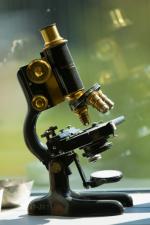|
This section contains 750 words (approx. 3 pages at 300 words per page) |

|
Aquatic microbiology is the science that deals with microscopic living organisms in fresh or salt water systems. While aquatic microbiology can encompass all microorganisms, including microscopic plants and animals, it more commonly refers to the study of bacteria, viruses, and fungi and their relation to other organisms in the aquatic environment.
Bacteria are quite diverse in nature. The scientific classification of bacteria divides them into 19 major groups based on their shape, cell structure, staining properties (used in the laboratory for identification), and metabolic functions. Bacteria occur in many sizes as well ranging from 0.1 micrometer to greater than 500 micrometers. Some are motile and have flagella, which are tail-like structures used for movement.
Although soil is the most common habitat of fungi, they are also found in aquatic environments. Aquatic fungi are collectively called water molds or aquatic Phycomycetes. They are found on the surface of decaying plant...
|
This section contains 750 words (approx. 3 pages at 300 words per page) |

|


